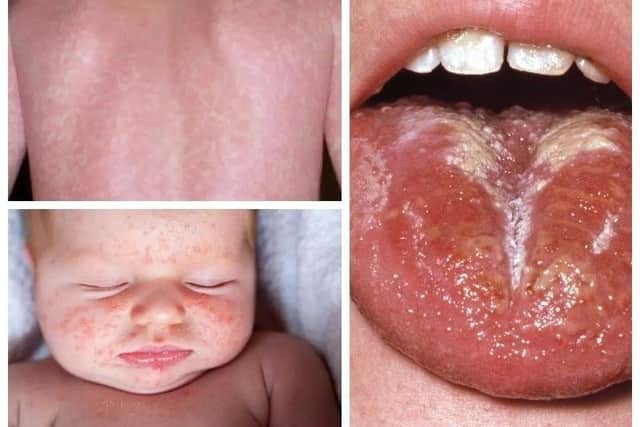Strep A Sheffield: Number of scarlet fever cases in South Yorkshire as warning issued to parents at schools
and live on Freeview channel 276
But only one case was recorded in the city during the latest week, new figures show, and there have been no cases logged anywhere in South Yorkshire during the last 10 weeks of invasive group A streptococcal infection, or iGAS, which has killed a number of children in the UK this year.
Scarlet fever, the symptoms of which include a rash, temperature, sore throat and swollen neck glands, is caused by the strep A bacteria but is not usually serious and can typically be easily treated. It is only when the bacteria overcome your body’s immune defences, leading to iGAS, that the infection usually becomes more serious and in some cases fatal. The warning signs of this include a temperature above 38C, severe muscle aches, pain in one area of the body and unexplained vomiting or diarrhoea, with people advised to seek urgent medical help if these symptoms are present.
How many cases of scarlet fever have been recorded in Sheffield and elsewhere in South Yorkshire?


Advertisement
Hide AdAdvertisement
Hide AdThe UK Health Security Agency publishes weekly statistics about the number of notifiable diseases, including scarlet fever, recorded across England and Wales. For the latest week, ending on December 4, there was just one case of scarlet fever recorded in Sheffield, compared to 32 on the Isle of Wight, which had the most, and 22 in Leeds. There were three cases in Rotherham, one each in Barnsley and Doncaster, and a total of 1,131 across England and Wales.
Looking at the figures for the last 10 weeks, going back to the week ending on October 2, there have been a total of 58 cases of scarlet fever recorded in Sheffield, with a high of 12 cases logged during the week ending on November 20. Across South Yorkshire, there have been 106 cases of scarlet fever, including 22 in Rotherham, 15 in Barnsley and 11 in Doncaster.
Scarlet fever cases have been rising steadily in England and Wales, with just 260 infections recorded during the week ending on October 20, compared with 1,131 in the seven days to December 4. But there have only been four cases in the last two weeks in Sheffield, compared to 19 in the fortnight before that. The highest weekly number of cases in South Yorkshire was 24, recorded during the week ending on October 30.
The number of scarlet fever cases in the UK has recently increased above the levels expected at this time of year, particularly among children aged under 10 years old, and nine children in the UK have died with rare but severe bacterial strep A infections since September.


Advertisement
Hide AdAdvertisement
Hide AdSheffield’s director of public health, Greg Fell, and the city’s consultant in communicable disease control, Nachi Arunachalam, have written to parents and carers of children across the city urging them to look out for the symptoms of scarlet fever and telling them what to do if they think their child might be infected.
What are the symptoms of scarlet fever and what should I do if I think my child is infected?
The letter states: “Scarlet fever is a common childhood infection caused by Streptococcus pyogenes, or group A Streptococcus (GAS). It is not usually serious, but should be treated with
antibiotics to reduce the risk of complications (such as pneumonia) and spread to others.
“The early symptoms of scarlet fever include sore throat, headache, fever, nausea and vomiting. After 12 to 48 hours, the characteristic red rash develops, usually first on the chest and stomach, then rapidly spreading to other parts of the body, making the skin have a sand-paper like feel to it. The scarlet rash may be harder to spot on darker skin, although the 'sandpaper' feel should be present. Patients usually have flushed red cheeks. They may also have a bright red ‘strawberry’ tongue.”
Advertisement
Hide AdAdvertisement
Hide AdIf you think you or you child might have scarlet fever, you are advised to contact your GP or NHS 111 as soon as possible, to make sure you or you child completes the full course of any antibiotics prescribed, even if they start to feel better sooner, and to stay at home, away from nursery, school or work, for at least 24 hours after starting the antibiotic treatment, to avoid spreading the infection.
Frequent hand washing, not sharing eating utensils, clothes, bedding and towels, and the immediate disposal of any contaminated tissues are also recommended to help stop the spread of infection.
The same bacteria which cause scarlet fever can also cause a range of other infections, including a sore throat and skin infections (impetigo). In rare cases the bacteria can get into the bloodstream and cause invasive group A strep. It is very rare, however, for children with scarlet fever to develop iGAS.
The letter to parents advises them to contact their GP or NHS 111 if:
their child is getting worse
their child is feeding or eating much less than normal
Advertisement
Hide AdAdvertisement
Hide Adtheir child has had a dry nappy for 12 hours or more or shows other signs of dehydration
their baby is under three months and has a temperature of 38C, or is older than three months and has a temperature of 39C or higher
their baby feels hotter than usual when they touch their back or chest, or feels sweaty
their child is very tired or irritable.
They should call 999 or go to A&E if:
their child is having difficulty breathing – they may notice grunting noises or their child’s tummy sucking under their ribs
there are pauses when their child breathes
their child’s skin, tongue or lips are blue
their child is floppy and will not wake up or stay awake.